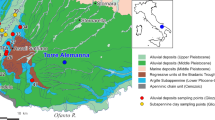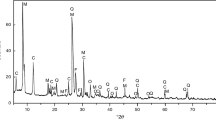Abstract
Two kinds of samples of Early and Late Neolithic ceramic sherds of pots from excavations of sites located in Dnepr–Dvina and Low Don region (Serteya II and Rakushechny Yar) were investigated for multi-analytical comparison. The methods include thermogravimetric analysis, X-ray powder diffraction, X-ray photoelectron spectroscopy and method of standard contact porosimetry. The pottery manufactured in Serteya II and Rakushechny Yar has different clay sources, but close mineral composition. Inner sides of sherds are less thermally durable as a result of the contact with cooking meal or boiling water in ancient times: They lose more mass during thermogravimetric measurements. At the same time, the minerals in outer sides of the samples are partly destroyed because of contact with fire in the past. According to differential scanning calorimetry curves, there are thermal effects above 1000 °C in all sherds due to mullite formation. There are organic C–F bonds and sharp endothermic peaks at 600–750 °C in samples from Serteya II site. In addition to elevated level of nitrogen and phosphorus and carbon black layer on the inner side, it allows to propose that the pot from Serteya II was used for cooking. The sherds from both sites have close overall porosity, but in case of Serteya II size of mesopore is more isotropic.








Similar content being viewed by others
References
Annamalai GR, Ravisankar R, Rajalakshmi A, Chandrasekaran A, Rajan K. Spectroscopic characterization of recently excavated archaeological potsherds from Tamilnadu, India with multi-analytical approach. Spectrochim Acta A Mol Biomol Spectrosc. 2014;133:112–8.
Drebushchak VA, Mylnikova LN, Drebushchak TN. Thermoanalytical investigations of ancient pottery. J Therm Anal Calorim. 2018;133:135–76.
Drebushchak VA, Mylnikova LN, Molodin VI. Thermogravimetric investigation of ancient pottery. Metrological analysis of sampling. J Therm Anal Calorim. 2007;90:73–9.
Drebushchak VA, Mylnikova LN, Drebushchak TN. The mass-loss diagram for the ancient ceramics. J Therm Anal Calorim. 2011;104:459–66.
Ponta O, Vulpoi A, Zirra V, Simon S. Structural and compositional investigation of ancient ceramics from a fortified settlement in south-western Romania. J Mol Struct. 2016;1122:157–63.
Issi A, Kara A, Alp A. An investigation of Hellenistic period pottery production technology from Harabebezikan/Turkey. Ceram Int. 2011;37:2575–82.
Bayazit M, Isik I, Issi A, Genc E. Spectroscopic and thermal techniques for the characterization of the first millennium AD potteries from Kuriki-Turkey. Ceram Int. 2014;40:14769–79.
Ribeiro RP, Kobelnik M, Parizotto JCV. Mineralogical and thermal characterization of soft rock from Campinas, Brazil. J Therm Anal Calorim. 2019;136:483–92.
Nagy E, Guttmann M, Molnar-Kovacs Z, Barabas R. Multi-method analysis of bronze age ceramics from Satu-Mare County, Romania. Stud Univ Babes-Bol Chem. 2015;4:21–34.
Singh P, Sharma S. Thermal and spectroscopic characterization of archeological pottery from Ambari, Assam. J Archaeol Sci Rep. 2016;5:557–63.
Perez-Rodriguez JL, Perez-Maqueda R, Franquelo ML, Duran A. Study of the thermal decomposition of historical metal threads. J Therm Anal Calorim. 2018;134:15–22.
Klouzkova A, Kavanova M, Kohoutkova M, Zemenova P, Dragoun Z. Identification of causes of degradation of Gothic ceramic tiles by thermal analyses. J Therm Anal Calorim. 2016;125:1311–8.
Rotaru A, Lupascu T, Paladi F. Thermal analysis and calorimetry in the study of materials and processes for fundamental sciences and various applications in Central and Eastern Europe. J Therm Anal Calorim. 2018;134:1–5.
Moraru L, Cotoi O, Szendrei F. Euler number: a method for statistical analysis of ancient pottery porosity. Eur J Sci Theol. 2011;7:99–108.
Stevenson CM, Gurnick M. Structural collapse in kaolinite, montmorillonite and illite clay and its role in the ceramic rehydroxylation dating of low-fired earthenware. J Archaeol Sci. 2016;69:54–63.
Benea M, Lazarescu V-A, Gorea M. Contribution to the study of suceag pottery, Cluj County, Romania. Stud Univ Babes-Bol Chem. 2016;2:73–8.
Bahceli S, Gulec G, Erdogan H, Sogut B. Micro-Raman and FT-IR spectroscopic studies of ceramic sherds from ancient Stratonikeia city at Eskihisar village in West-South Turkey. J Mol Struct. 2016;1106:316–21.
de Soto IS, Gimenez RG, de Soto MR. Roman ceramic pieces from central Spain: visual, textural, chemical, mineraljgical and statistical analysis. Mediter Archaeol Archaeom. 2016;16:237–48.
Lamara S, Redaoui D, Sahnoune F, Daheb N. Effect of temperature and magnesia on phase transformation kinetics in stoichiometric and non-stoichiometric cordierite ceramics prepared from kaolinite precursors. J Therm Anal Calorim. 2019;137:11–23.
Dejoie C, Tamura N, Kunz M, Goedeau P, Sciau P. Complementary use of monochromatic and white-beam X-ray micro-diffraction for the investigation of ancient materials. J Appl Crystallogr. 2015;48:1522–33.
Issi A. Estimation of ancient firing technique by the characterization of semi-fused Hellenistic potsherds from Harabebezikan/Turkey. Ceram Int. 2012;38:2375–80.
Lahlil S, Xu J, Li W. Influence of manufacturing parameters on the crackling process of ancient Chinese glazed ceramics. J Cult Herit. 2015;16:401–12.
Liou YS. Multi-technique study of archaeological cord-marked wares decorated with red coatings from Taiwan. J Raman Spectros. 2015;46:133–40.
Maggetti M, Serneels V, Stasch G. Composition and technology of 18th century high magnesia faïences from Fulda. J Archaeol Sci Rep. 2015;2:40–50.
Bakolas A, Aggelakopoulou E. Pozzolanic activity of natural pozzolan–lime pastes and physicomechanical characteristics. J Therm Anal Calorim. 2019;135:2953–61.
Perisic N, Maric-Stojanovic M, Andric V, Mioc UB, Damjanovic L. Physicochemical characterisation of pottery from the Vinča culture, Serbia, regarding the firing temperature and decoration techniques. J Serb Chem Soc. 2016;81:1415–26.
Seetha D, Velraj G. Characterization and chemometric analysis of ancient pot sherds trenched from Arpakkam, Tamil Nadu, India. J Appl Res Technol. 2016;14:345–53.
Vieira Ferreira LF, Gonzalez A, Pereira MFC, Santos LF, Casimiro TM, Ferreira DP, Conceicao DS, Ferreira Machado I. Spectroscopy of 16th century Portuguese tin-glazed earthenware produced in the region of Lisbon. Ceram Int. 2015;41:13433–46.
Issi A, Ozcatal M, Kara A, Alp AO. Production technology and provenance study of brittle wares belonging to the late roman period from Harabebezikan/Turkey. Ceram Int. 2017;43:2182–7.
Jiang X, Chen Y, Zhang L, Zhang Z, Ma Q, Wang C, Yang Y. Prototype Doucai porcelain—a special form of ancient Honglvcai in Cizhou kiln, Jin Dynasty (1115–1234 AD), China. Ceram Int. 2017;43:1371–7.
Medeghini L, Fabrizi L, De Vito C, Mignardi S, Nigro L, Gallo E, Fiaccavento C. The ceramic of the “Palace of the Copper Axes” (Khirbet al-Batrawy, Jordan): a palatial special production. Ceram Int. 2016;42:5952–62.
Tempere J-F, Delafosse D. An X-ray photoelectron spectroscopy study on zeolites. Chem Phys Lett. 1975;33:95–8.
Winiecki AM, Suib SL, Occelli ML. X-ray photoelectron spectroscopy investigations of zeolites. Langmuir. 1988;4:512–8.
Kulkova M, Mazurkevich A, Dolbunova E, Regert M, Mazuy A, Nesterov E, Sinai M. Late Neolithic subsistence strategy and reservoir effects in 14C dating of artifacrs at the pile-dwelling site Serteya II (NW Russia). Radiocarbon. 2015;57:611–23.
Volfkovich YM, Bagotzky VS, Sosenkin VE, Blinov IA. The standard contact porosimetry. Colloids Surfaces A Physicochem Eng Asp. 2001;187–188:349–65.
Acknowledgements
Research was conducted using resources provided by the Centre of Thermal Analysis and Calorimetry, Centre of Physical methods of Surface Investigation, and the Centre for X-ray Diffraction Studies of Research Park of Saint Petersburg State University.
Author information
Authors and Affiliations
Corresponding author
Additional information
Publisher's Note
Springer Nature remains neutral with regard to jurisdictional claims in published maps and institutional affiliations.
Rights and permissions
About this article
Cite this article
Zvereva, I.A., Kuznetsov, V.M., Zhukov, Y.M. et al. Thermal analysis and multi-analytical comparison of samples of Neolithic ceramics from Dnepr–Dvina and Low Don regions. J Therm Anal Calorim 138, 1879–1886 (2019). https://doi.org/10.1007/s10973-019-08621-x
Received:
Accepted:
Published:
Issue Date:
DOI: https://doi.org/10.1007/s10973-019-08621-x




